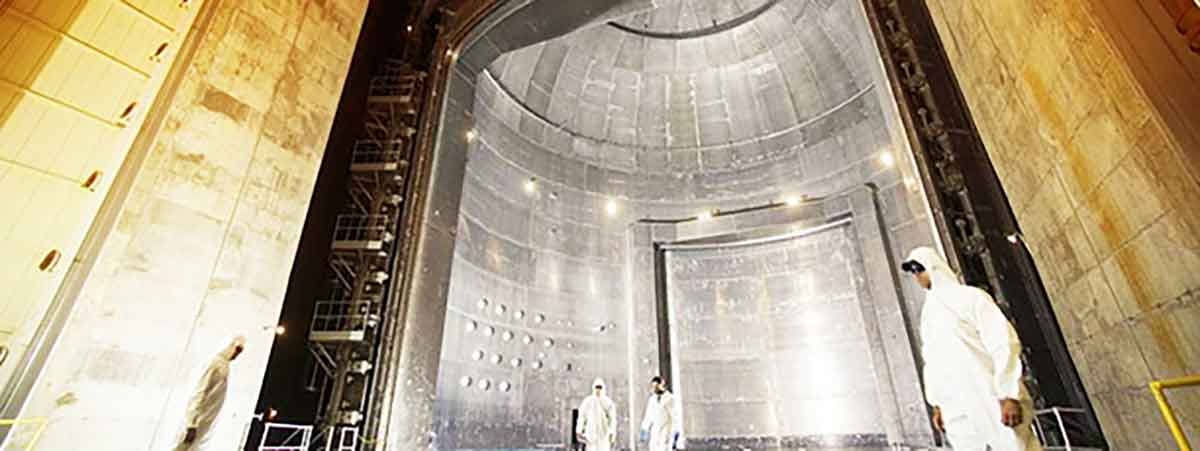Before launching equipment into space, NASA sends material to the Glenn Research Center in the US state of Ohio. Its suitability for the extreme conditions in the vacuum of the universe is tested here.
Galileo's dream
The white dome on the NASA research site near Sandusky in the north of the US state of Ohio curves over the Space Simulation Vacuum Chamber. At a height of 37 meters and a diameter of 30 meters, it is the largest vacuum chamber in the world. Galileo Galilei would have been delighted if it had already existed during his lifetime. In this huge room you can empirically observe that his laws of falling bodies are correct and that a handful of feathers fall down just as quickly as a bowling ball.
Tests for ISS and Mars mission
Thanks to its technical equipment, the chamber, which was built as early as 1969, is suitable both as an experimental field for basic research and for testing new industrial developments. However, it is mainly used by NASA engineers as a test room for all kinds of hardware that will later be used in space. Satellites, probes, propulsion stages for missiles, crew capsules and moon vehicles have already been driven in here and exposed to extreme conditions similar to those prevailing in space. The experts also examined, for example, whether and how the solar sails of the International Space Station ISS hold up in vacuum. At the moment, the center's experiments are focusing on the Mars mission. Tests are being performed on the airbag landing system for two Mars-mobiles, for example.
In addition to the space vacuum, simulations include the large temperature fluctuations in space and the strong UV radiation of the sun. The internal temperature of the chamber can be heated to 60 degrees Celsius and cooled down to minus 160 degrees Celsius. Quartz lamps with an output of 4400 kilowatts are used to create an artificial sun effect.
State-of-the-art vacuum pumps
The interior of the chamber is lined with aluminium and has a volume of 22,653 cubic metres. This corresponds approximately to the capacity of ten Olympic swimming pools. An outer layer of concrete up to 2.4 meters thick protects the structure from external forces when the 15-by-15 metre doors on the sides of the chamber close at the push of a button and the air pressure gradually drops inside.
Various vacuum pumps are combined, including rotary vane and turbomolecular vacuum pumps in order to achieve the ultra-high vacuum of space. It takes several hours for 30 tons of air to be transported out. Only about two grams remain inside the chamber. The air pressure is 0.000000000013 bar or 130 micropascal. This corresponds to one billionth of the atmospheric pressure on Earth.

Outer space on earth
Huge vacuum chamber in Ohio simulates the conditions of space
For what would Galileo have needed a vacuum chamber?
Do heavy objects fall faster than light objects? Aristotle asked this question around 300 B.C. and later postulated on the basis of his observations that the rate of fall of a body depends on its mass. After Galileo Galilei had spent some time considering the movement of falling bodies almost 2000 years later, he doubted the ancient scholar's theory: he noticed that air resistance plays a role. So he constructed an inclined plane and let a brass ball roll down it many times. In doing so, he repeatedly varied the slope, changed the test conditions and determined the running time of the sphere with the help of bells, a water meter and his own pulse.
From his results he came to certain conclusions on the movement of bodies in free fall and established the first laws:
1. The rate of fall (v) of a body increases proportionally to the time of fall (t).
2. The distance fallen (h) increases proportionally to the square of the time of fall (t2).
The body's mass or shape does not affect the fall distance or its fall speed. However, Galileo was well aware that his attempt was only able to provide approximate values. He would have needed a vacuum chamber for a precise check – one a little smaller than the one in Ohio would have sufficed. After all, it is only without air resistance, inside vacuum, that all bodies actually fall at the same speed. The fact that Galileo came to correct conclusions without a vacuum chamber makes his scientific achievement even greater.
Do heavy objects fall faster than light objects? Aristotle asked this question around 300 B.C. and later postulated on the basis of his observations that the rate of fall of a body depends on its mass. After Galileo Galilei had spent some time considering the movement of falling bodies almost 2000 years later, he doubted the ancient scholar's theory: he noticed that air resistance plays a role. So he constructed an inclined plane and let a brass ball roll down it many times. In doing so, he repeatedly varied the slope, changed the test conditions and determined the running time of the sphere with the help of bells, a water meter and his own pulse.
From his results he came to certain conclusions on the movement of bodies in free fall and established the first laws:
1. The rate of fall (v) of a body increases proportionally to the time of fall (t).
2. The distance fallen (h) increases proportionally to the square of the time of fall (t2).
The body's mass or shape does not affect the fall distance or its fall speed. However, Galileo was well aware that his attempt was only able to provide approximate values. He would have needed a vacuum chamber for a precise check – one a little smaller than the one in Ohio would have sufficed. After all, it is only without air resistance, inside vacuum, that all bodies actually fall at the same speed. The fact that Galileo came to correct conclusions without a vacuum chamber makes his scientific achievement even greater.